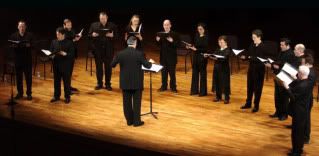I have now seen all three productions in the inaugural series from the new tripartite Theatre of the Small-Eyed Bear, comprised of three Off-Off Broadway companies which have economized by sharing production costs, space, and design teams, subsuming their individual identities as well.
From a technical standpoint, the operation has been a success. All three plays, for example, share one easily modifiable set (by the talented Elisha Schaefer). There's one publicist, one graphic designer, one technical team. All good.
As for the productions themselves, they're a mixed bag. David McGee's Mare Cognitum, reviewed last week, had some fine writing and very good performances, but sacrificed dramatic integrity for philosophical meandering.
Lenny Schwartz's Squiggy and the Goldfish is painted in brighter, childish colors, which lends weight to its theme of abuse, but it too suffers from a weakness of focus.
At the center of Squiggy is a brave, sharp performance by Josh Breslow as the title character. Abuse at the hands of his suicidal father has made him a cutter of long standing, though he's successfully hidden his scars from his ineffective, half-unmoored mother (Dana Aber). Terrorized by his cruel fiancée Veronica (the excellent Katrina Ylimaki) and her violent father (Jonathan Miles), Squiggy gets no relief even in his dreams, where a horror-movie psychiatrist and a nightstick-happy cop chase him through paranoid fantasies.
Salvation appears in the form of Blossom (Elyse Ault), a clerk at the pet shop where Squiggy goes to seek a cure for his excessively voluble goldfish, Goldie. This animal spirit, played with comic bluster by Eric C. Bailey, leads Squiggy through the this-is-your-life sequence that forms most of the action, and at first Goldie is a very funny beast. But Mr. Schwartz and the director, Michael Roderick, relegate him further and further into the background as they gradually reveal the story of Squiggy's unfortunate life. In the process we learn more about the women he loves as well – his mother, his fiancee, and then Blossom.
As they reveal themselves, the characters stimulate aches of recognition, but the effect is too often subverted by Recovery Movement catchphrases, characters stating the obvious to one another, and narrative inconsistencies. Goldie informs Squiggy he is to die in a week, but a revelation at the end seems to tell a different story. Mr. Breslow does absolutely all he can to keep the play centered, but he can do only so much.
Duncan Pflaster's Ore, or Or, the most successful of the three plays, also makes use of dream sequences, but here they are in the context of a well-rounded, coherent drama about relationships and racial identity. It is also staged with much starker realism than the other plays; though it's the same theater, we feel we're in an entirely new and somehow larger physical space. The crafty lighting and brittle, economical set create the illusion of more depth on stage, and Mr. Pflaster lights it up with an artfully constructed, well-aimed, and resonant story.
The action flows quickly, thanks to director Laura Moss, and that's good, because these characters have much to go through. The tale is essentially a classic love triangle, with the beefy Calvin Kanayama (E. Calvin Ahn) at the apex. He seems to love his new girlfriend, down-to-earth Debbie (Elizabeth Erwin), but lusts after the lithe and forward Tara (Clara Barton Green). Along the way he bonds with Sean (Shawn McLaughlin), Debbie's gay roommate, who, through no fault of his own, suffers from knowing more than he wants to about his friends' love lives. In creating a supportive and single "gay best friend," Mr. Pflaster flirts with cultural stereotype, but comes out pure, as Sean flowers into the most likable and vivid character of all.
The action skips deftly through one seriocomic situation after another. The mostly solid cast has fun with video games, food poisoning, Star Trek, and Sean's adventures as a substitute teacher. Periodically, a gong and some evocative shakuhachi music divert us into one of Calvin's dreams. These have been touched off by his work at the Metropolitan Museum of Art, where he's researching some gold figures that just might come from the legendary Yamashita's treasure. This sub-theme is an appealing, ornate framing device, though perhaps not totally necessary, as the imperfect, realistically rough-edged New Yorkers living their laughing, heartbreaking lives in front of us are intriguing enough by their plain selves. Still, without the dream sequences, we wouldn't have the lovely costumes and the great score, and they do provide some neatly dramatic moments as well, so who's complaining? The car may be a little used, but the paint job is smooth and the engine runs very well. Climb aboard; this is a worthwhile trip.
Squiggy and the Goldfish and Ore, or Or play in repertory through May 30 at the Workshop Theater, 312 W. 36 St., NYC. Tickets are only $12.
 Appropriately, the set is a circle, both cagelike and circusy. Coiling through is the serpent, evoked by Davon Rainey, who also delivers several interesting and illuminating (and highly crowd-pleasing) drag numbers.
Appropriately, the set is a circle, both cagelike and circusy. Coiling through is the serpent, evoked by Davon Rainey, who also delivers several interesting and illuminating (and highly crowd-pleasing) drag numbers.
